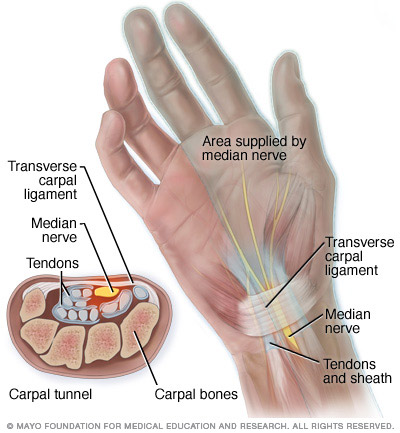What is Carpal Tunnel Syndrome?
Carpal Tunnel Syndrome is a condition in which the median nerve is compressed as it passes through an opening from the wrist to the hand called the carpal tunnel. The carpal tunnel is formed by the carpal bones on the bottom of the wrist and the transverse carpal ligament across the top of the wrist.

Causes
Carpal Tunnel has no specific cause, although any or all of the following may serve as a contributing factor:
- Frequent, repetitive, small movements with the hands (such as with typing or using a keyboard)
- Frequent, repetitive, grasping movements with the hands (such as with sports and certain physical activities)
- Joint or bone disease (for example, arthritis, osteoarthritis or rheumatoid arthritis)
- Hormonal or metabolic changes (for example, menopause, pregnancy or thyroid imbalance)
- Changes in blood-sugar levels (may be seen with type 2 diabetes)
- Other conditions or injuries of the wrist (for example, strain, sprain, dislocation, break or swelling and inflammation)
Symptoms
- The most common symptoms for Carpal Tunnel Syndrome may include:
- Weakness when gripping objects with the hand
- Pain and/or numbness in the hand
- “Pins and needles” feeling in the fingers
- Swollen feeling in the fingers
- Burning or tingling in the fingers, especially the thumb and the index and middle fingers
- Pain and/or numbness that is worse at night, interrupting sleep
- Always consult your doctor first for a diagnosis.
- Treatment
- Treatment may include:
- Changing position of a computer keyboard or other ergonomic changes
- Splinting of the hand to help prevent wrist movement and decrease the compression of the nerves inside the tunnel
- Oral or injection of anti-inflammatory medications to reduce the swelling into the carpal tunnel space
- Surgery to relieve compression on the nerves in the carpal tunnel
- Surgery
- In general, the surgery for carpal tunnel syndrome is performed in an outpatient location under local or general anesthesia. The traditional method is the open release, in which the surgeon cuts open the wrist to perform the surgery. The tissue that is pressing on the nerves will then be cut in order to decrease the pressure. The newer method is endoscopic carpal tunnel release, in which a tube that contains a camera is inserted through a tiny incision. The camera guides the doctor as he or she performs the procedure.
- In either case, here is the general sequence of events in a carpal tunnel release surgery:
- You will usually be asked to remove clothing, or at least your shirt, to allow the surgeon to work more easily.
- Typically, local anesthetic is used for this procedure to numb the hand and wrist.
- In an open release surgery, the surgeon cuts a two-inch incision on the wrist. Then he or she uses common surgical instruments to cut the carpal ligament and enlarge the carpal tunnel.
- In an endoscopic carpal tunnel release, the doctor makes two half-inch incisions. One is on the wrist, and one is on the palm. Then he or she inserts a camera attached to a tube into one incision. The camera guides your doctor as he or she inserts the instruments and cuts the carpal ligament through the other incision.
- The surgeon will stitch up the incision or incisions.
- Your hand and wrist will be placed in a splint or bandaged heavily.
- After the surgery, the wrist may be immobilized in a large dressing and wrist brace to help stabilize the area. The splint is usually worn continuously for the first two weeks after the surgery, but then is used intermittently for the next month or so. There is a moderate degree of pain in the hand after the surgery, which is usually controlled with pain medications taken orally. The surgeon may also have you keep the affected hand elevated while sleeping at night. Once the surgery is complete, you will be monitored for a short time and then allowed to go home. Only in rare instances or complications is an overnight stay required for a carpal tunnel release surgery.
- The length of recovery varies for each individual. If the nerve has been compressed for a long period of time, recovery may take longer. Movement of the fingers and wrists are encouraged a few days following surgery to help prevent stiffness.
- After surgery, most people begin a physical therapy program. The physical therapist will provide you with motion exercises to improve the movement of the wrist and hand. These exercises will speed healing and strengthen the damaged body parts.
- Risks
- As with most invasive surgeries, carpal tunnel release is not without its risks. You will usually be put under local anesthesia for the procedure, which poses risks for some people. Other potential risks of a carpal tunnel release surgery include:
- Excessive bleeding at the surgery site
- Infection at the site
- Injury to the median nerve or nerves that branch out from it
- Injuries to surrounding blood vessels
- A sensitive scar
- Carpal tunnel release is not a procedure that you can immediately recover from. The recovery process can take several weeks to several months and involves physical therapy to strengthen and heal the wrist and hand.
If you think you may have carpal tunnel syndrome, download our free guide which includes causes, symptoms and treatment.
Learn more about our carpel tunnel care.
Call for an appointment today! 304-599-0720

